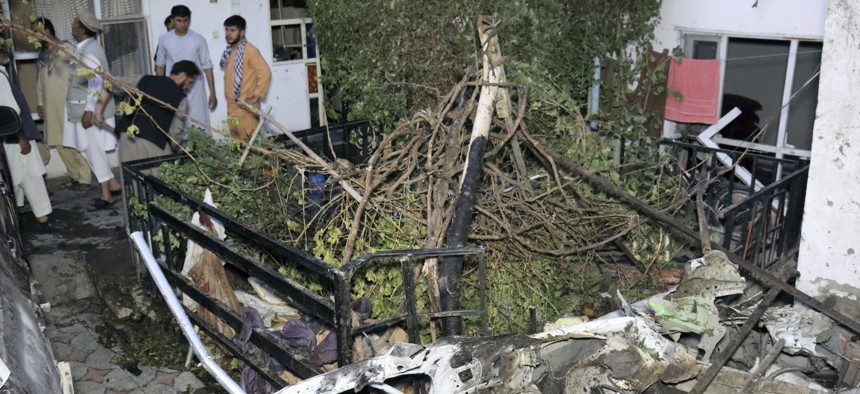
Afghans inspect damage of Ahmadi family house after U.S. drone strike in Kabul, Afghanistan, Aug. 29, 2021. AP / Khwaja Tawfiq Sediqi
‘Horrible Mistake’: Pentagon Admits Drone Strike Killed Children, Not Terrorists
After just eight hours of surveillance and a tip about a “white Toyota Corolla,” the U.S. fired a Hellfire missile on Aug. 29 at the wrong target.
The decision to fire a Hellfire missile that accidentally killed 10 Afghan civilians last month was based not on the solid identification of ISIS-K fighters, but a series of coincidences and assumptions, the head of U.S. Central Command told reporters Friday.
The mistakes in the Aug. 29 strike in Kabul raises questions about how the U.S. will prevent more civilian deaths in future planned “over-the-horizon” strikes aimed at terror groups in Afghanistan.
McKenzie said part of the cause for the Aug. 29 tragic mistake was the limitation of time. In future over-the-horizon strikes, “we will have an opportunity to further develop the target in time,” he said.
“To look at pattern of life. That time was not available to us, because this was an imminent threat to our forces. It's important that I emphasize that we did not have the luxury of time to develop pattern of life and do a number of other things. We struck under the theory of reasonable certainty. Probably our strikes in Afghanistan going forward will be under a higher standard.”
McKenzie outlined the series of events that led up to the deaths of the civilians.
Just 36 hours before firing the Hellfire, the “over-the-horizon” strike cell commander had been notified that “ISIS-K would utilize a white Toyota Corolla as a key element in the next attack,” Marine Corps Gen. Frank McKenzie told reporters at the Pentagon on Friday.
In response, the U.S. tasked as many as nine MQ-9 Reapers to watch an “area of interest” associated with ISIS, and spotted a white Corolla. After it left that initial area, the drones tracked it to six other locations, including a humanitarian site that U.S. forces identified as an aid location after the attack, McKenzie said.
In a horrible coincidence, as the civilians in the Corolla were unloading jugs and supplies at Nutrition and Education International, where one of the drone strike victims, Zemari Ahmadi, was employed, U.S. forces were receiving additional intelligence that an ISIS cell leader was receiving supplies at the same time, McKenzie said.
The New York Times first identified aid worker Zemari Ahmadi and nine family members. Including seven children, as the victims of the Aug. 29 attack.
At the final stop, the Ahmadi home, which was close to Hamid Karzai International Airport, “the vehicle was observed being approached by a single adult male assessed at the time to be a co-conspirator,” McKenzie said.
He did not further discuss how the man was identified as a co-conspirator, and at no time did McKenzie say that any additional identifying intelligence, such as facial recognition or identifying known associates, was engaged to back up the decision to fire.
“When the vehicle came up to the final point, that point seven on your map, which is actually, as I've noted, as close to the closest to the airfield it had been all day. We were very concerned about a white Corolla being involved in an attack, so the cumulative force of all those, all those, the intelligence that we gathered throughout the day, the position of the vehicle, it’s newness to the airport, the imminence of the threat and the other [signals intelligence] that we're getting throughout the day, all led us to the moment of deciding to take the strike.”
“Clearly, our intelligence was wrong on this particular white Toyota Corolla,” McKenzie said.
Just three days before, an ISIS-K suicide bomber killed 13 U.S. service members and 170 Afghans at the airport’s Abbey Gate, and there was an urgency to prevent what they thought was another imminent attack, McKenzie said.
“We now know that there was no connection between Mr. Ahmadi and ISIS-Khorasan, that his activities on that day were completely harmless and not at all related to the imminent threat we believed we faced, and that Mr. Ahmadi was just as innocent a victim as were the others tragically killed,” Defense Secretary Lloyd Austin said in a statement.
“We apologize, and we will endeavor to learn from this horrible mistake,” Austin said.







